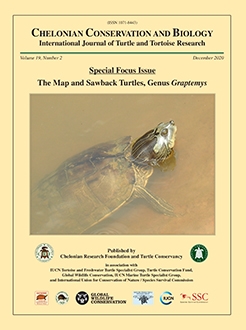C. J. McCoy, Oscar A. Flores-Villela, Richard C. Vogt, Michael Pappas, J. Kelly McCoy
Chelonian Conservation and Biology 19 (2), 197-208, (31 December 2020) https://doi.org/10.2744/CCB-1447.1
KEYWORDS: Graptemys, Pearl River, Cahaba River, Chickasawhay River
As part of an integrated study of the ecology of freshwater riverine turtle communities in the southern United States, we analyzed food resource partitioning in the turtle communities of the Cahaba, Chickasawhay, and Pearl rivers. We collected turtles with an array of unbaited fyke nets for periods of 10 d from 1 July to 13 August 1978 and 30 April to 4 August 1979, capturing 2707 turtles of 16 species in 2428 trap days. We successfully flushed the stomach contents from 729 turtles of the following species: Apalone mutica, Apalone spinifera, Graptemys flavimaculata, Graptemys gibbonsi, Graptemys nigrinoda, Graptemys oculifera, Graptemys pearlensis, Graptemys pulchra, Pseudemys concinna, Sternotherus carinatus, Sternotherus peltifer, and Trachemys scripta. We also caught 4 other species in low numbers: Chelydra serpentina, Graptemys pseudogeographica kohnii, Macrochelys temminckii, and Sternotherus odoratus. Stomach contents were identified and quantified by volume and percentage of occurrence for each species from each river. Food items were identified and placed in 6 categories: crustaceans, insects, mollusks, fish, plants, and unidentified. Pseudemys concinna was the most specialized feeder at all 3 sites, feeding almost exclusively on plants, followed by the wide-headed Graptemys and then narrow-headed Graptemys. Specialist species tended to show extensive niche overlap with any other species that consumed a large proportion of the specialists' preferred foods.

